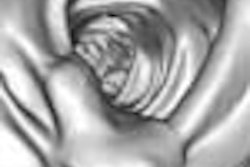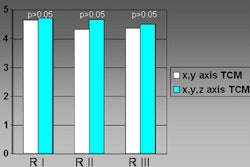A negative chest CT exam -- even single-slice -- is enough to rule out pulmonary embolism (PE), according to a meta-analysis published today in the Journal of the American Medical Association.
By relying on negative spiral CT as a front-line test to rule out PE, physicians can also minimize radiation exposure, avoid invasive angiography, and reduce healthcare costs without undue risk to the patient, concluded lead investigator Dr. U. Joseph Schoepf and colleagues from the Medical University of South Carolina (MUSC) in Charleston, along with researchers from Boston's Brigham and Women's Hospital and Harvard Medical School.
Their conclusions are based on a meta-analysis of 15 studies that examined 3,500 patients with suspected pulmonary embolism, and followed them up for three to 12 months. The researchers calculated the rate of subsequent pulmonary embolism after anticoagulation therapy was withheld as a result of a negative chest CT study.
The most reliable way to determine the accuracy of a diagnostic test is to perform a prospective study using a diagnostic criterion with a high negative predictive value (NPV), the group wrote. Pulmonary angiography is the standard of reference for excluding PE, but it has limited interobserver agreement for subsegmental emboli, with ranges of 45% to 66% reported, they explained.
"Thus, a validation study of chest CT compared with pulmonary angiography will not necessarily determine the true diagnostic accuracy," Schoepf and colleagues wrote. "A practical approach to establish the validity of CT for ruling out clinically significant pulmonary embolism is to investigate the rate of a subsequent venous thromboembolic event (VTE) after anticoagulant therapy was withheld after a negative chest CT scan" (JAMA, April 27, 2005, Vol. 293:16, pp. 2012-2017).
To find their 15 studies, the group searched the medical databases PubMed, Medline, EMBASE, CRISP, and others for appropriate studies published in 1990 or later. The criteria included appropriate clinical follow-up of at least three months, more than 30 patients, peer-reviewed publication, and chest CT performed on all patients. Studies that were poorly performed, used D-dimer testing, or lacked appropriate follow-up of VTEs were excluded.
From each of the 15 studies included in the analysis, the researchers identified all cases of PE or deep vein thrombosis (DVT) reported at three, six, and 12 months after CT.
"To calculate the overall negative likelihood ratio of a VTE after a negative or inconclusive chest CT scan for pulmonary embolism, we included VTEs that were objectively confirmed during clinical follow-up," Schoepf and colleagues wrote. "Patients who received anticoagulant therapy for reasons other than VTE during follow-up were excluded from the analysis. We used prevalence of pulmonary embolism from each of the studies as an estimate of prior probability."
The MUSC team also assessed heterogeneity among studies, examined publication bias, and obtained summary estimate and 95% confidence interval for VTE and deaths related to PE. They used meta-regression to analyze the impact of additional imaging tests and the effect of the particular CT modality in the results. (Twelve of the studies used single-slice CT, two used multidetector-row CT, and two used electron-beam CT.)
In all, 3,500 patients from Austria, Canada, France, Ireland, the Netherlands, Sweden, and the U.S. were evaluated between 1994 and 2002, with 153 nondiagnostic scans, and 190 patients lost to follow-up.
"A total of 36 pulmonary embolism events and six deep vein thrombosis (without pulmonary embolism) events were observed at months three, four, six, or 12," they wrote. "There were 15 deaths attributable to VTE, either by autopsy (10 studies) or record review of death certificates (15 studies). The overall (negative predictive value) for mortality attributable to pulmonary embolism was 99.4% (95% CI, 98.7%-99.9%) and the overall NLR (negative likelihood ratio) was 0.01 (95% CI, 0.01-0.02)."
The overall NLR of a venous thromboembolic event after a negative chest CT scan was 0.07 (95% CI, 0.05-0.11), and the NPV was 99.1% (95% CI, 98.7%-99.5%).
The use of MDCT rather than single-slice CT made little difference. The NLR after single-slice CT was 0.08 (95% CI, 0.05-0.13), and after multislice CT it was 0.15 (95% CI, 0.05-0.43), the group reported. Nor did the use of additional imaging tests before CT make a significant difference.
Finally, the overall NLR of mortality attributable to PE after negative CT was 0.01 (95% CI, 0.01-0.02) for an overall NPV of 99.4% (95% CI, 98.7%-99.9%), the team reported.
Following up patients for more than three months didn't produce additional benefits, either. Compared with studies that performed three-month follow-up, the relative risk (RR) of a venous thromboembolic event was not increased in studies that performed follow-up beyond three months (RR, 1.05; 95% CI, 0.42-2.52; p = 0.11).
"Pooled results involving 15 studies and 3,500 patients with suspected pulmonary embolism suggest that clinical outcome is not adversely affected if anticoagulant therapy is withheld based on a negative CT scan," Schoepf and colleagues wrote. "The overall NPV of 99.1% for VTEs in our analysis compares favorably with previously reported NPVs of 98.4% and 100% when pulmonary angiography was used, and is superior to a negative/low probability ventilation perfusion scan (range, 75.9%-88%)."
As for limitations, inaccurate detection of isolated emboli is a principal limitation of CT, the group noted. However, the significance of such clots is unclear, and in any case, this shortcoming is expected to diminish with the development of multiple detector rows.
In addition, additional imaging tests performed in some of the studies may have served to increase CT's negative predictive value. And the accuracy of CT accuracy in this task depends to some extent on risk factors in the population, the group wrote.
"Overall, our results suggest that withholding anticoagulant therapy after a negative CT scan appears to be safe," they wrote. "Additional imaging for ruling out pulmonary embolism is not warranted." A CT-only strategy will also minimize radiation exposure and the need for invasive procedures, they stated.
"No other imaging test used for diagnosing PE has been more thoroughly evaluated, in such an overwhelming number of patients, than spiral CT in this current analysis," lead investigator Schoepf wrote in an e-mail to AuntMinnie.com. "Thus, the evidence is there that CT is the new gold standard for imaging pulmonary embolism."
By Eric Barnes
AuntMinnie.com staff writer
April 27, 2005
Related Reading
Multidetector CT does not improve outcomes of suspected PE, April 12, 2005
CT venography plus CTPA finds more pulmonary embolism, February 1, 2005
CT imaging alone may be suitable for workup of pulmonary embolism, November 22, 2004
MDCT detects PE incidentally, December 30, 2004
CT for PE: Best test gets better, September 10, 2004
Copyright © 2005 AuntMinnie.com



















